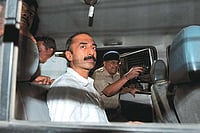Osama bin Laden is typical of the charismatic leader, steeped in religious bigotry, who can sway the illiterate and impoverished masses of his co-religionists to whom only faith and hope matter. Yet such a leader’s immediate entourage comprises the intelligent, educated, middle class, sometimes even well-heeled, members of his own community or religious belief who have been fed a steady diet of religious fundamentalism. Such leaders are able to inspire devotion and even love in those who follow them. Witness the case of Jarnail Singh Bhindranwale in the Punjab.
Osama’s induction as a proponent of terrorism in the cause of Islam took place in Afghanistan and was facilitated by the likes of Al-Zawahiri, an Egyptian doctor who came into contact with Osama in Afghanistan and had a profound impact on Osama’s thinking, as did Abdulla Azam, another Egyptian who invented the world’s first truly international jehadist network.
Peter Bergen feels that a simple hatred for Israel is not the only factor that motivates bin Laden and his associates. According to him, Osama articulates a worldview that goes beyond the concept of the nation-state and encompasses a vision of an Islamic brotherhood stretching from Turkey to Indonesia. There is no reason to dispute this analysis. Any ordinary observer will note that a common Muslim’s faith in god exceeds that of the followers of other beliefs at this point of time. About 12,000-15,000 Muslims from Saudi Arabia, Yemen, Egypt, Algeria, Chechnya and Pakistan served bin Laden’s Al Qaeda in the decade-long war against the Soviets in Afghanistan. That war is over but as many as 4,000 "Afghan Arabs" continue to fight for him wherever he commands.Bergen answers some pertinent questions. Was bin Laden a creation of the cia and the US as widely reported? Will his terror end after the US kills or captures him and drives the Taliban from power? Why is the US so detested in the Muslim world when its government has no particular enmity with Muslims?
Bergen’s explanation for the US being the target of bin Laden’s Holy War differs from Samuel Huntington’s treatise, The Clash Of Civilisations. Both theories can be applied mutatis mutandis to various events that have taken place at different times and at different places. The author has narrated the basic facts of the terrorist attacks on US interests and nationals beginning with the bombing of hotels in Yemen and including the bombing of the two US embassies in Kenya and Tanzania, the attacks on the USS Cole in Aden and on a US servicemen’s facility in Saudi Arabia. These attacks were well planned and carried out with the same precision that informed the unexpected destruction of the wtc twin towers and the Pentagon on 9/11. These attacks targeted the economic and military might of the US, considered to be a superpower keeping down Muslims in different parts of the world according to the perpetrators. The euphoria of victory against another superpower in Afghanistan had convinced Al Qaeda enthusiasts that god was on their side and that Islam would again rise after many years of decline.
Bergen’s account of the Al Qaeda network will convince the reader that the end of the current Afghanistan conflict will not usher in peace and contentment for the US or the world. The network is now so interwoven and spread all over the globe that another fanatical leader can easily replace Osama.
The author refutes the suggestion that the US created bin Laden in its anxiety to topple the Soviets in Afghanistan. But he does point out that the cia erred in giving a free hand to Pakistan’s isi and allowing Brig Mohammad Yusuf who was in charge of the isi’s Afghan operations to back Gulbuddin Hekmatyar, a known extremist and anti-western fanatic, instead of Ahmed Shah Masood who would have been a much better choice. India would certainly not have been very far from the isi’s calculations when it made that choice but Bergen does not allude to this aspect at all though he does refer to the ties between the Al Qaeda and the Kashmiri terrorist group, the Harkat-ul-Mujahideen.
After reading the book one gathers that the war against terrorism won’t end very soon. The Islamic warriors may find it conducive to turn their attention to Kashmir. The Americans would be well advised to discourage them because they cannot allow a monster to trouble one part of the globe and expect it not to turn its attention to them at another time.
(The author is former DGP in Punjab and author of Bullet for Bullet.)























